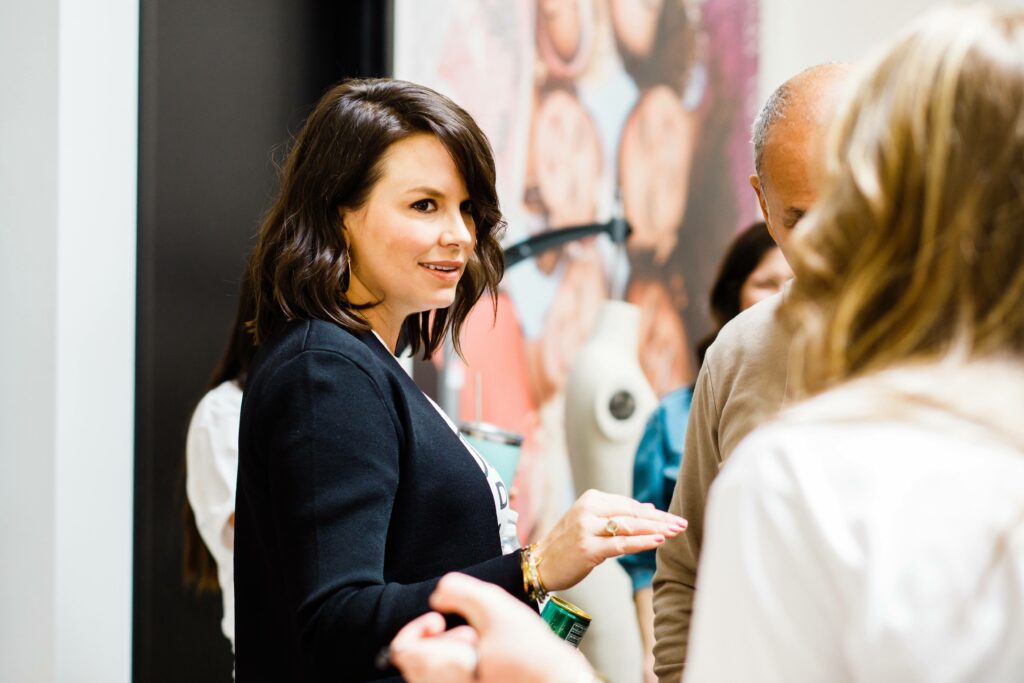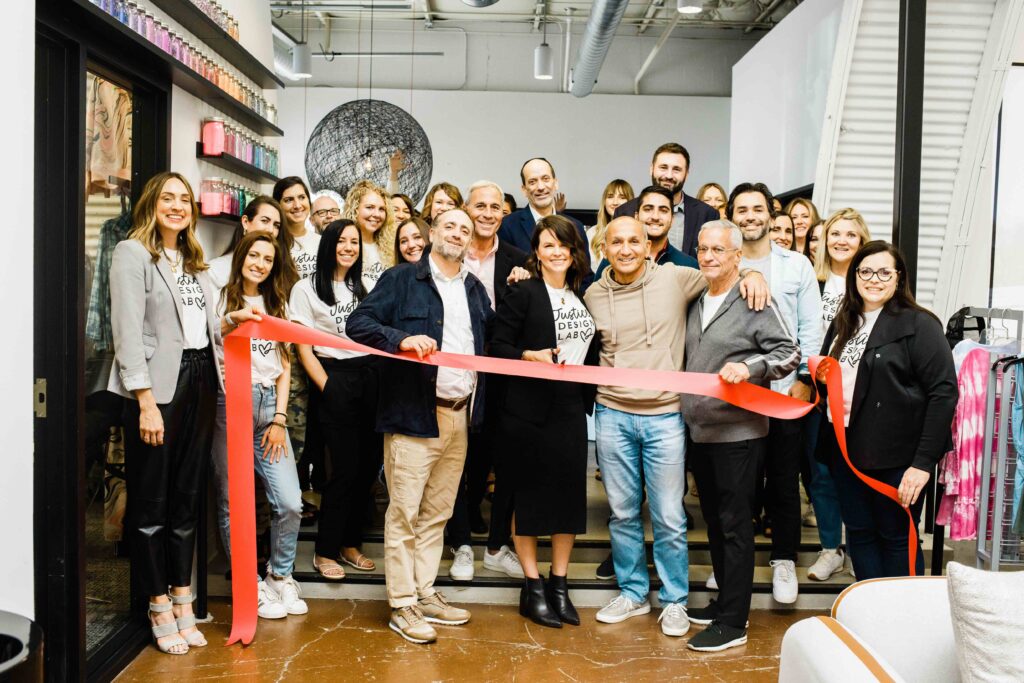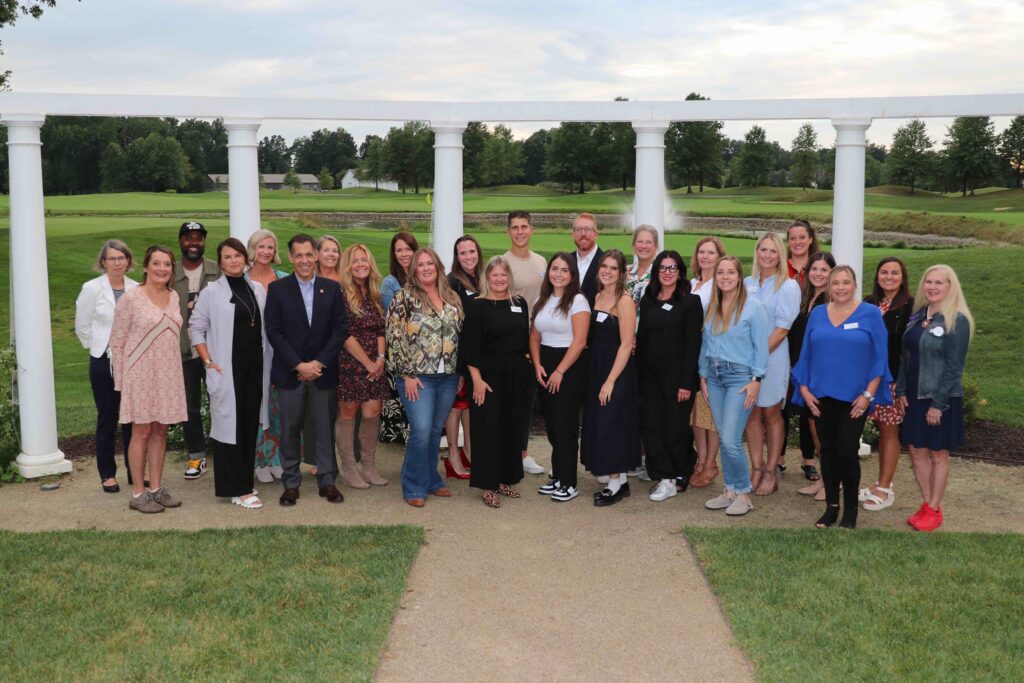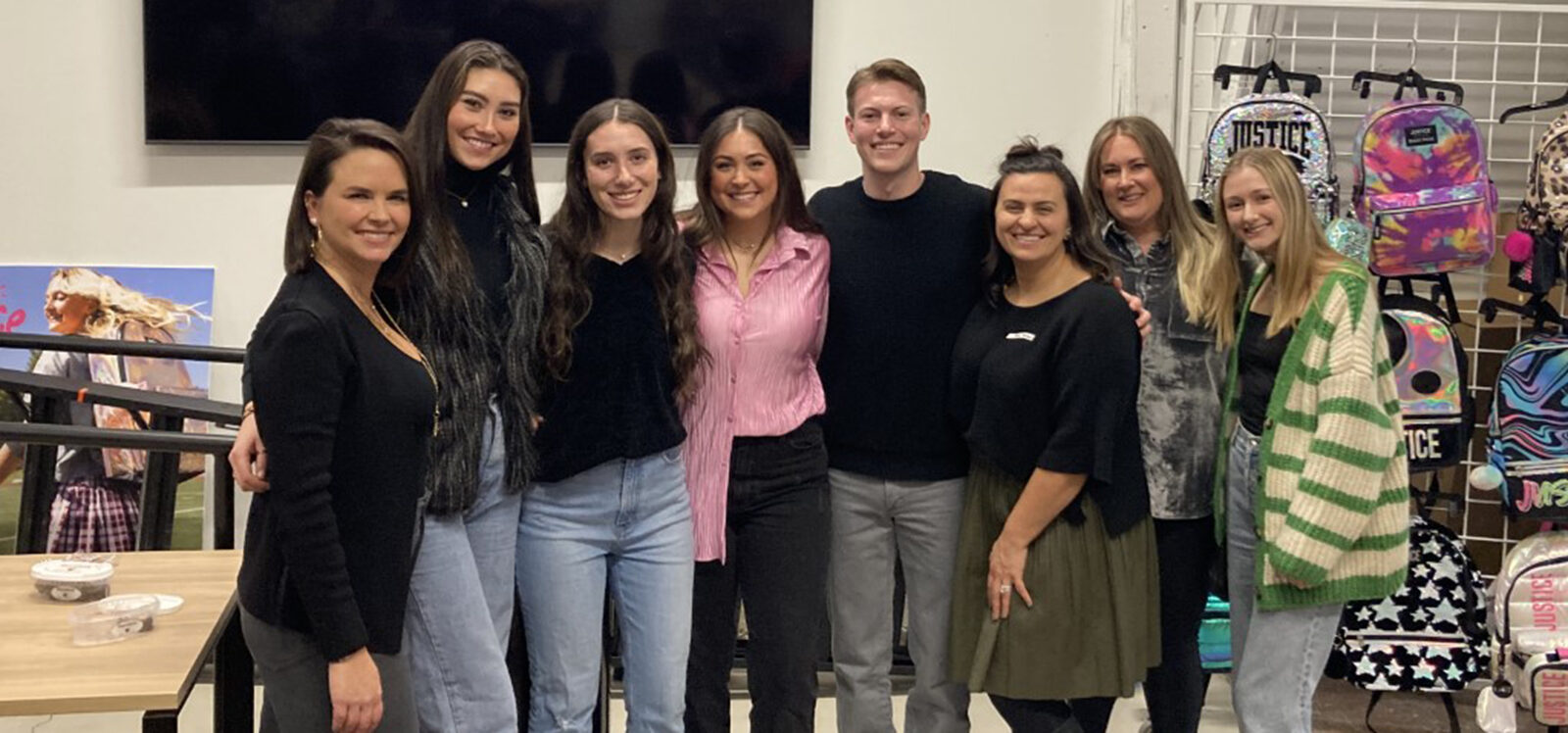As President of Justice Design Lab, she stands at the helm of the country’s number one brand for trendy tween clothing at affordable prices.
She sits on the college’s Fashion and Retail Studies Advisory Board, recently received the college’s Alumni Society Career Achievement Award and is well known for her expertise within the clothing industry worldwide.
So, how did Kat DePizzo, ’03 BS, rise to this level of success? Through talent, grit and gumption, hard work and something she calls relatability. Her interest in retail was fueled, in part, when as a tween herself, she followed her vice president dad to his health and beauty retail accounts to set up product inventories.
“We used to go to Graceland (shopping center in Columbus) late at night, and I would help him set up planograms, which are inventories of products in a section like hair care or makeup,” she said. “I loved being a part of it with him.”
“If shelves were a mess, we reorganized them. It was all about enticing the customer. How you want it to come to life visually. The art and math of how to set it up. I’ve always believed that if you build it in a way that tells the right story, you’re curating an experience for a customer, and they will buy it. I got hooked on how creating a visual with product translates into sales.”

As for the relatability, DePizzo’s personality tests show she’s the type who relates well to people. “That’s my nature, to understand people, and I think that translates well into understanding your customer.”
She quickly learned how to respond to customer needs and interests when, at 14, she took a summer job as a clerk at the local hardware.
“When a guy walked in (wanting a power tool) and said, ‘I need somebody who can speak my language,’ I made it my mission to know all the products, where they were on the floor, how they were used,” DePizzo said in a 2022 interview with 610 WTVN’s Columbus CEOs You Should Know. To this day, she loves her own power tools.
Higher education: How to be a great artist without majoring in art
Growing up, “I was creative, and I loved art or crafts,” DePizzo said, “but I was not the best drawer or painter. So, I used fashion as a way to express myself. … That does not mean I’m fancy all the time. I was the last of three girls, so I wore a lot of hand-me-downs. It was more about getting creative with how I put it together.”
Thanks to her retail-oriented father and her mother, a lawyer and CPA, DePizzo had a business mindset. So, at Ohio State, she chose to major in business.
Yet, as she moved through the program, the fit didn’t feel quite right. Leafing through the university catalog one day, she paused on the program then called Textiles and Clothing. An appointment with a faculty member introduced her to one of her favorite mentors.
“Dr. Nancy Rudd was a huge advocate in my journey,” she said.

DePizzo found the program to be an exciting mix of the full business cycle of fashion and retail, along with the science and technical aspects of quality fabric and clothing construction. Courses covered the history of fashion, sourcing and buying, manufacturing, retail management and merchandising, as well as the art of fashion design.
Rudd and the other faculty also emphasized designing for the customer’s positive body image.
“I’m so glad I had that experience,” DePizzo said, “because today, my job is to empower (tween) girls to feel their best selves every day. My team and I take that very seriously.”
The program’s computer-aided design courses allowed DePizzo to bring her artistic ideas to life. “I could put my ideas on a computer faster than I could draw them,” she said. “I ended up being the (teaching assistant) for the class. It gave me such a leg up when I went to work at Abercrombie and Fitch.”
Computer-aided design was new, and many companies still relied on sketching. “It really helped accelerate my career,” she said.
But before finding that first job after college, DePizzo experienced a case of the jitters. “I was nervous that nobody would look at my portfolio because it wasn’t amazing. I still have it. It was not amazing. But I had worked in all these stores and had well-rounded experience and learning at Ohio State.”
DePizzo had indeed racked up vast experience serving customers. “I sold food behind a grill counter during a hot summer; I’ve sold men’s, women’s, boys’ and girls’ apparel; I’ve sold shoes,” she said. She even sharpened her visual merchandising skills by using part of her job as a manager at Max Studio, a luxury brand, as her for-credit internship.
“But I thought I would need to move to a place like NYC to get a graduate degree in design,” she said. “And I thought I might not fit in there.”
Then Rudd sat her down and pointed out that Columbus was a city growing rapidly in fashion and retail, with major brand headquarters and budding designers launching companies.
You can jump into this industry here, Rudd told her. You are ready.
Rudd’s prediction proved correct.
Steady advancement is stymied by adversity
Once DePizzo had her foot in the industry door, whirlwind years followed. She joined the industry, and within a few years, she was working with top division leaders – first at Hollister, then with Abercrombie and Fitch in its heyday.
She started in design and was soon traveling the world. “A lot of production was done with our offices in Hong Kong, Seoul, Vietnam, India,” she said. “Then we would travel to see what was happening in the markets — London, Madrid, Paris, Tokyo and Miami, LA, Boston.”
When she moved to Justice, DePizzo had found her niche. She’d worked for brands that catered to men, women, girls, boys. But she liked focusing on the tween customer, understanding their needs and interests and creating appropriate products.

She worked her way up in the company, eventually landing as vice president of trend, design/concept and technical design.
Then, the pandemic roared into the world and people stopped going to stores. Sales income collapsed. Retail companies began laying off employees in waves.
DePizzo endured a state of instability. She asked herself daily: “How do I save this brand that I love? It means so much to so many people. And how do I save as many jobs as I possibly can?” That was her focus.
So, when the Justice parent company decided to auction off the brand, and employees were instructed to stop going to work, she refused. She kept going.
“Because if we didn’t, and if we were actually sold, we were going to miss developing back-to-school, the most important season. It would have been a make-or-break moment,” she said.
DePizzo gathered a skeleton crew to work at her home.
“I had every supplier shipping boxes from overseas to my garage,” she said. “I moved out the cars, and we would unpack and stack the boxes. On a sunny day, when we were avoiding coming within six feet of each other, we would wear gloves, masks and have meetings on my driveway. We would lay out samples, and I’d be up on a ladder taking pictures. Neighbors thought I was crazy.”
“A normal deal would have been to license the brand out of New York,” she said. “There would have been no ‘us’ designing and leading from Columbus. So, I was determined to keep our model alive, to protect the DNA and authenticity of this amazing brand, but also to keep business and opportunity and jobs alive in this city.”
It was the hardest thing she’d ever done, DePizzo said. But, also, the most rewarding. Because ultimately, BlueStar Alliance LLC bought the brand and asked her to lead it.

At the top of her game, thanks to Ohio State
Today, after three years leading Justice Design Lab, with clothing sold exclusively by Walmart, Kat DePizzo credits Ohio State for the critical content she gained while a student.
“When traveling overseas, I would take what I learned about fibers, construction, how products are made — not everyone had that background — and apply it to sourcing and production questions.”
Today, if she and her design team want to create a particular garment feature or use a special fabric, and a supplier says it can’t be done, she has the technical savvy to explain how it can.
She credits Faculty Emeritus Charles Noel for teaching her about the science of textile fibers. That knowledge parleyed into how some Justice swimwear is made from recycled fabric.
Nancy Rudd, now faculty emerita, taught her about the critical importance of creating clothing that supports positive body image.
“When girls no longer fit into clothes designed for little kids with a younger aesthetic, where are they supposed to go?” DePizzo said. “Junior brands are not designed for tween girls. (Tweens) are starting to get their sense of style and unique identity, but nothing in those stores fits them, nor is it appropriate for them.”
Justice steps in to fill that gap of creating age-appropriate items that allow tweens to express their style and that parents are comfortable with their daughters wearing. “If we have a skirt, we attach a pair of shorts to it, so if that girl wants to do cartwheels, she can,” DePizzo said.
She emphasizes that Justice keeps its designs relevant. “I think one of the biggest mistakes we as retailers can make is putting our heads in the sand and pretending that we’ve set the bar of who our customers are, and we’re not going to change even if they do,” she said.
DePizzo and her team study the trends in women’s clothing and look at styles worldwide. They follow the tween influencers, conduct focus groups with tween girls and host tween guests to their headquarters, such as Girl Scouts Troops, to learn what they like.
“We work to give our customer what they’re looking for,” DePizzo said, “because as a world, we’ve gone through so much change just in the past three years, that our priorities today are different than they were last year.”
Now she’s giving back, to the college, to Columbus
DePizzo and her team want to give back, even as they gain needed information. “I like to consider what I do now as circular — I can learn, work hard and create, then give back by creating opportunity.”

DePizzo is as an active volunteer on the college’s Fashion and Retail Studies Advisory Board. A small group at first, it met to discuss support that the program needed. Since then, “the board has grown tenfold,” she said. Her contributions have evolved, and now more people from Justice are leaders on the board as well.
“We donate to scholarships, to student events,” she said. “But more important than dollars are our time and mentorship. We advise about what students need to learn to succeed in the industry. We speak in their classes. We do tours so they can spend time with our business, whether it’s sourcing or design, packaging or marketing, photo studio or social media. We have all that in house, and our doors are open.”
DePizzo personally mentors many students and stays connected with them on their journeys. Other team members do, too, and Justice has hired some alumni, including Erin Sweeney Hollander, ’07 BS, Textiles and Clothing, who is now design director of Justice Design Lab and has served on the advisory board since 2019.
People don’t realize that Columbus is number three in the country for resident fashion and retail designers. … I want people to know they should be looking at Columbus for fashion. I don’t want people to move away, I want them to be here.
Kat DePizzo
Hollander, board members Aimee Koontz (a program manager with Abbott Nutrition), and independent executive consultant Chris Williams, Senior Lecturer Kristin Paulus and Clinical Associate Professor Julie Hillery nominated DePizzo for a Career Achievement Award from the college’s Alumni Society in 2022. They wrote:
“Kat has been an integral part of the leadership vision of the Fashion and Retail Studies Advisory Board … she contributed her leadership by … helping recruitment and evaluation in our faculty searches and providing mentoring and internship placements for our students. Additionally, she has literally opened her doors for our industry board and students to collaborate in a design space, fostering an extension of our Fashion and Retail Studies program. Furthermore, she has been a generous donor by supplying her resources for industry board and student gatherings.”
“People don’t realize that Columbus is number three in the country for resident fashion and retail designers,” DePizzo said. That’s according to Bloomberg. And columbusregion.com highlights the Columbus area as No. 4 among large U.S. metros for concentration of retail headquarters.
“I want people to know they should be looking at Columbus for fashion,” she said. “I don’t want people to move away, I want them to be here. I’m grateful to be a part of it. I’m grateful I never left it.”

